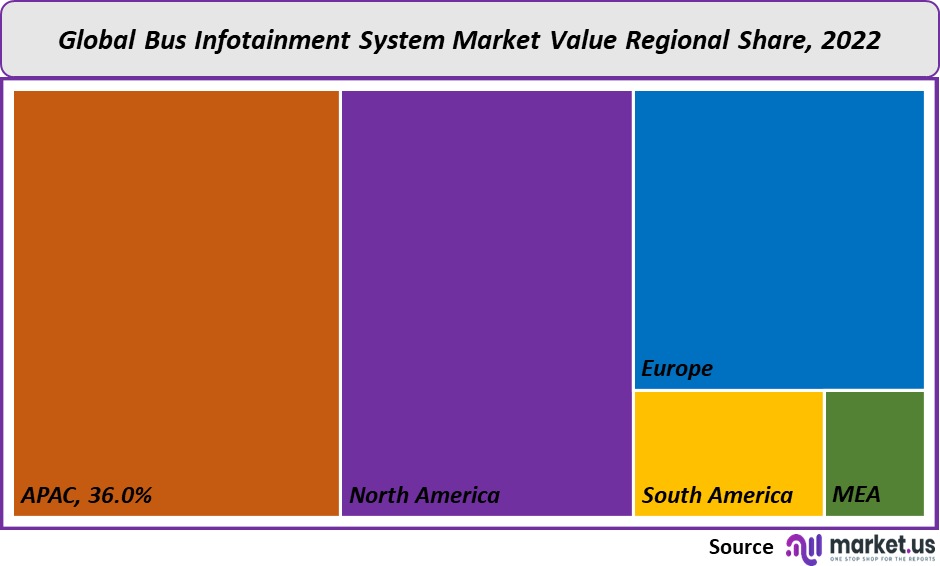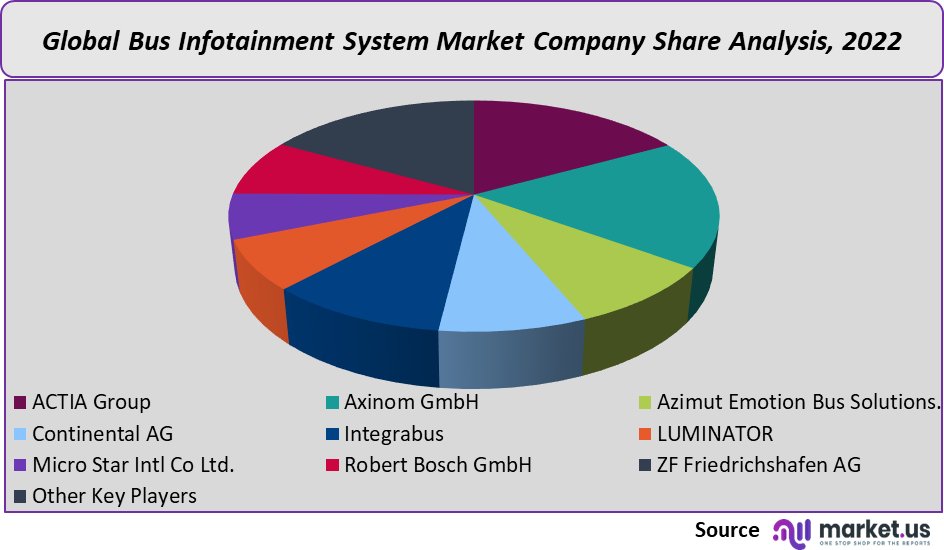Global Bus Infotainment System Market by Type (Hardware Devices , Software System), By Application (Passenger Car , Commercial Vehicle), By Region and Companies - Industry Segment Outlook, Market Assessment, Competition Scenario, Trends and Forecast 2023-2032
- Published date: May 2023
- Report ID: 49674
- Number of Pages: 288
- Format:
- keyboard_arrow_up
Quick Navigation
Bus Infotainment System Market Overview
The global bus infotainment system market is estimated to be valued at USD 0.23 billion in 2022, with a CAGR of 9.6% during the forecast period. It is expected to reach USD 0.58 billion. There are several potentials for expansion in the in-car infotainment system industry, including the inclusion of smartphone support capabilities, infotainment system integration with other systems, & rising demand for rear-end-seat infotainment systems.
Transit users desire 24/7 access to information in this digital age. One of the best ways to give information to passengers is through a shuttle, train, or bus entertainment system, often even before they are aware they need it. It would help the customers if they received real-time updates on their journey as a transit company. By giving them the information they need to feel less stressed or uncertain when traveling, care can be shown to the passengers.

This market report gives a detailed analysis of the bus infotainment system market size, share, growth, key trends, market players, market scenario by region, and other factors. The market study allows us to understand current market dynamics, the supply-demand gap, supply forces, and pricing trends. It also helped us to identify consumer patterns, price preferences, product preferences, and so forth.
Global Bus Infotainment System Market Scope:
Product Type Analysis
The global bus infotainment system market for bus infotainment systems is divided based on two product types: hardware devices & software systems. It consists of hardware and software components found in automobiles that offer information and recreation in games, social networking, audio, video material, etc. The systems frequently include navigation and vehicle diagnostics, assisting drivers in safer rides.
A platform and software for infotainment may also include information about the area, the weather, advertisements, digital streams of exciting content, and much more. Due to their superior efficiency over conventional ones, Software systems are being used more frequently globally. In recent years, this has been the primary market driver.
Application Analysis
The global bus infotainment system market is divided into passenger cars & commercial vehicles. Passenger cars are motor cars with at least four wheels that are meant to carry people & have no more than eight-seat total, excluding the driver’s seat. The bus infotainment system industry is expanding quickly due to consumer electronics and technological advances. The system is being developed to include more and more innovative tools. Every infotainment electronic control unit (ECU) is networked on the automotive platform.
The goal of infotainment systems in passenger cars is to provide enjoyment & information using button panels, touchscreen displays, & audio/video interfaces. It permits hands-free access to texts, calls, & emails for the drivers, combined with smartphone assimilation services. In contrast, commercial vehicles are automobiles with at least four wheels used to transport cargo.
Drivers can pair their devices to access their favorite music playlists and other digital libraries. Some infotainment systems vehicles even have monitors that the passengers sitting in the back can view from the middle or rear seats. These allow passengers sitting in the back to watch movies or play video games while the car is stationary or moving. Furthermore, due to more severe accidents in commercial vehicles, there is an increase in demand which is anticipated to accelerate the growth of this industry.
Key Market Segments
By Type
- Hardware Devices
- Software System
By Application
- Passenger Car
- Commercial Vehicle
Market Dynamics:
Smartphone support capabilities with the in-vehicle entertainment system are the primary factor propelling the worldwide bus infotainment system market’s growth. Customers expected the same interactivity from in-car entertainment & information systems as they interacted more frequently with their mobile devices.
People have connected their smartphones and tablets to their vehicles’ infotainment systems to obtain improved entertainment and information. Bus infotainment makers are also incorporating smartphone support elements that are simple to use, like Wi-Fi systems, charging connections and online phone applications. It will assist the market’s growth in the forthcoming years as consumers’ needs change.
The industry trend for bus infotainment systems that are anticipated to have a favorable impact on the sector in the estimated period is the use of advertisement as a new source of income for many OEMs through vehicle infotainment. It will help the bus infotainment system market’s expansion even more in the upcoming years. For instance, automobile OEMs are very interested in Rovi Corporation since it has a robust ad distribution infrastructure that can target ads based on viewing preferences.
For advertisers, converting their advertisements into actual transactions is the ultimate purpose of in-vehicle advertising. However, to expand the adoption of this concept and support the sector’s growth, small businesses (in the advertising industry) must collaborate closely with many other bus infotainment system market stakeholders.
The diversions caused by integrating the infotainment system are one of the main restraining factors to expanding the global bus infotainment system industry. Even though premium infotainment systems include voice-activated functions, infotainment systems still require hand-held operations to access information.
When driving, distractions may cause brake delays, sluggish reflexes, or failure to notice visual cues. Additionally, the complexity of modern entertainment systems has grown due to the inclusion of several capabilities, which raises the risk of distracted driving. Thus, it is anticipated that the likelihood of accidents caused by distracted driving will rise as more buses and coaches are outfitted with multimedia systems.
COVID-19 Impact Analysis
The COVID-19 epidemic negatively impacted the APAC public transportation sector. Numerous public transportation systems were forced to temporarily close their facilities due to the implementation of strict lockdowns and social distance rules. Due to closure and rising energy prices, several bus service companies in nations such as India suffered enormous losses, which had a detrimental impact on the bus infotainment system market’s expansion.
However, since 2021 the region has been in a recovery phase, as seen by a decline in COVID-19 cases, rising vaccination rates, and looser government lockdown restrictions. During the forecast period, introducing new buses will fuel industry expansion.
Regional Analysis
During the forecast period, APAC will encounter 36% of market growth. China, India, Japan, and Russia are significant markets in Asia-Pacific for bus entertainment systems. This region will expand more quickly than those other areas. Over the projection period, the bus infotainment system industry would grow in APAC due to the significant rise in demand for in-vehicle entertainment systems from rising markets such as India, China, Thailand, and Indonesia.
Businesses in the Asia Pacific are also given opportunities to boost their manufacturing capacity, which helps to drive the potential bus infotainment system market. Thus, demand for bus entertainment systems will be predicted to rise in the APAC region throughout the forecast period.

Key Regions and Countries Covered in The Market Report:
- North America
- The US
- Canada
- Mexico
- Europe
- Germany
- The UK
- France
- Italy
- Russia
- Spain
- Rest of Europe
- APAC
- China
- Japan
- South Korea
- India
- Rest of Asia-Pacific Region
- South America
- Brazil
- Argentina
- Rest of South America
- Middle East & Africa
- GCC
- South Africa
- Israel
- Rest of MEA
New firms are breaking into the bus infotainment system market. Because of the increased global demand for technologically superior items, other significant firms are also preparing to introduce upcoming products. The number of commercially viable commodities for small-scale industries has expanded due to mergers and acquisitions among major firms, broadening the product line. As a result, there is a chance that these companies will face greater global competition.

Bus Infotainment System Market Key Players:
- ACTIA Group
- Axinom GmbH
- Azimut Emotion Bus Solutions.
- Continental AG
- Integrabus
- LUMINATOR
- Micro Star Intl Co Ltd.
- Robert Bosch GmbH
- ZF Friedrichshafen AG
- ACITA Group
- Luminator Technology Group
- Other Key Players
For the Bus Infotainment System Market research study, the following years have been considered to estimate the market size:
Attribute Report Details Market Size in 2022
USD 0.23 billion
Growth Rate
9.6%
Forecast Value in 2032
USD 0.58 billion
Historical Years
2016-2020
Base Year
2021
Estimated Year
2022
Short Term Projection Year
2028
Projected Year
2023
Long Term Projection Year
2032
Report Coverage
Competitive Landscape, Revenue analysis, Company Share Analysis, Manufacturers Analysis, Volume by Manufacturers, Key Segments, Key company analysis, Market Trends, Distribution Channel, Market Dynamics, COVID-19 Impact Analysis, strategy for existing players to grab maximum market share, and more.
Regional Scope
North America, Europe, Asia-Pacific, South America, Middle East & Africa
Country Scope
United States, Canada and Mexico, Germany, France, UK, Russia and Italy, China, Japan, Korea, India and Southeast Asia, Brazil, Argentina, Colombia etc.Saudi Arabia, UAE, Egypt, Nigeria and South Africa
Frequently Asked Questions (FAQ)
What will be the market size for Bus Infotainment System Market in 2032?In 2032, the Bus Infotainment System Market will reach USD 0.58 billion.
What CAGR is projected for the Bus Infotainment System market?The Bus Infotainment System market is expected to grow at 9.6% CAGR (2023-2032).
Name the major industry players in the Bus Infotainment System market.ACTIA Group, Axinom GmbH, Azimut Emotion Bus Solutions., Continental AG, Integrabus, and Other Key Players are the main vendors in Bus Infotainment System.
List the segments encompassed in this report on the Bus Infotainment System market?Market.US has segmented the Bus Infotainment System market by geographic (North America, Europe, APAC, South America, and MEA). By Type, market has been segmented into Hardware Devices and Software System. By Application, the market has been further divided into, Passenger Car and Commercial Vehicle.
 Bus Infotainment System MarketPublished date: May 2023add_shopping_cartBuy Now get_appDownload Sample
Bus Infotainment System MarketPublished date: May 2023add_shopping_cartBuy Now get_appDownload Sample - ACTIA Group
- Axinom GmbH
- Azimut Emotion Bus Solutions.
- Continental AG
- Integrabus
- LUMINATOR
- Micro Star Intl Co Ltd.
- Robert Bosch GmbH
- ZF Friedrichshafen AG
- ACITA Group
- Luminator Technology Group
- Other Key Players
- Nestlé S.A Company Profile
- settingsSettings
Our Clients
| Single User $4,599 $3,499 USD / per unit save 24% | Multi User $5,999 $4,299 USD / per unit save 28% | Corporate User $7,299 $4,999 USD / per unit save 32% | |
|---|---|---|---|
| e-Access | |||
| Report Library Access | |||
| Data Set (Excel) | |||
| Company Profile Library Access | |||
| Interactive Dashboard | |||
| Free Custumization | No | up to 10 hrs work | up to 30 hrs work |
| Accessibility | 1 User | 2-5 User | Unlimited |
| Analyst Support | up to 20 hrs | up to 40 hrs | up to 50 hrs |
| Benefit | Up to 20% off on next purchase | Up to 25% off on next purchase | Up to 30% off on next purchase |
| Buy Now ($ 3,499) | Buy Now ($ 4,299) | Buy Now ($ 4,999) |











